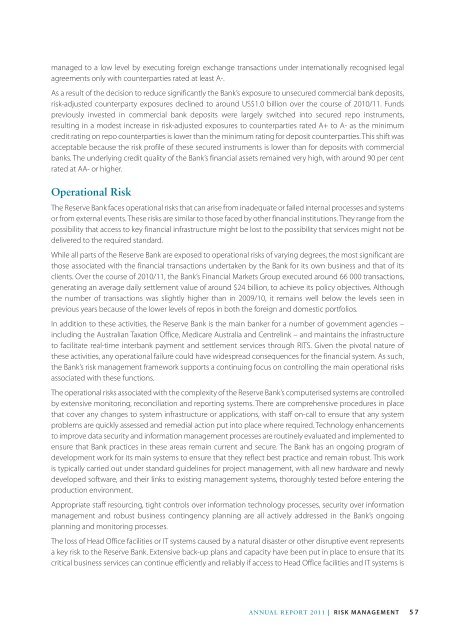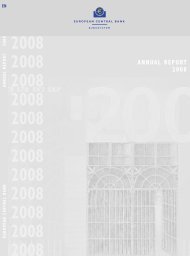Reserve Bank of Australia Annual Report 2011
Reserve Bank of Australia Annual Report 2011
Reserve Bank of Australia Annual Report 2011
Create successful ePaper yourself
Turn your PDF publications into a flip-book with our unique Google optimized e-Paper software.
managed to a low level by executing foreign exchange transactions under internationally recognised legal<br />
agreements only with counterparties rated at least A-.<br />
As a result <strong>of</strong> the decision to reduce significantly the <strong>Bank</strong>’s exposure to unsecured commercial bank deposits,<br />
risk-adjusted counterparty exposures declined to around US$1.0 billion over the course <strong>of</strong> 2010/11. Funds<br />
previously invested in commercial bank deposits were largely switched into secured repo instruments,<br />
resulting in a modest increase in risk-adjusted exposures to counterparties rated A+ to A- as the minimum<br />
credit rating on repo counterparties is lower than the minimum rating for deposit counterparties. This shift was<br />
acceptable because the risk pr<strong>of</strong>ile <strong>of</strong> these secured instruments is lower than for deposits with commercial<br />
banks. The underlying credit quality <strong>of</strong> the <strong>Bank</strong>’s financial assets remained very high, with around 90 per cent<br />
rated at AA- or higher.<br />
Operational Risk<br />
The <strong>Reserve</strong> <strong>Bank</strong> faces operational risks that can arise from inadequate or failed internal processes and systems<br />
or from external events. These risks are similar to those faced by other financial institutions. They range from the<br />
possibility that access to key financial infrastructure might be lost to the possibility that services might not be<br />
delivered to the required standard.<br />
While all parts <strong>of</strong> the <strong>Reserve</strong> <strong>Bank</strong> are exposed to operational risks <strong>of</strong> varying degrees, the most significant are<br />
those associated with the financial transactions undertaken by the <strong>Bank</strong> for its own business and that <strong>of</strong> its<br />
clients. Over the course <strong>of</strong> 2010/11, the <strong>Bank</strong>’s Financial Markets Group executed around 66 000 transactions,<br />
generating an average daily settlement value <strong>of</strong> around $24 billion, to achieve its policy objectives. Although<br />
the number <strong>of</strong> transactions was slightly higher than in 2009/10, it remains well below the levels seen in<br />
previous years because <strong>of</strong> the lower levels <strong>of</strong> repos in both the foreign and domestic portfolios.<br />
In addition to these activities, the <strong>Reserve</strong> <strong>Bank</strong> is the main banker for a number <strong>of</strong> government agencies –<br />
including the <strong>Australia</strong>n Taxation Office, Medicare <strong>Australia</strong> and Centrelink – and maintains the infrastructure<br />
to facilitate real-time interbank payment and settlement services through RITS. Given the pivotal nature <strong>of</strong><br />
these activities, any operational failure could have widespread consequences for the financial system. As such,<br />
the <strong>Bank</strong>’s risk management framework supports a continuing focus on controlling the main operational risks<br />
associated with these functions.<br />
The operational risks associated with the complexity <strong>of</strong> the <strong>Reserve</strong> <strong>Bank</strong>’s computerised systems are controlled<br />
by extensive monitoring, reconciliation and reporting systems. There are comprehensive procedures in place<br />
that cover any changes to system infrastructure or applications, with staff on-call to ensure that any system<br />
problems are quickly assessed and remedial action put into place where required. Technology enhancements<br />
to improve data security and information management processes are routinely evaluated and implemented to<br />
ensure that <strong>Bank</strong> practices in these areas remain current and secure. The <strong>Bank</strong> has an ongoing program <strong>of</strong><br />
development work for its main systems to ensure that they reflect best practice and remain robust. This work<br />
is typically carried out under standard guidelines for project management, with all new hardware and newly<br />
developed s<strong>of</strong>tware, and their links to existing management systems, thoroughly tested before entering the<br />
production environment.<br />
Appropriate staff resourcing, tight controls over information technology processes, security over information<br />
management and robust business contingency planning are all actively addressed in the <strong>Bank</strong>’s ongoing<br />
planning and monitoring processes.<br />
The loss <strong>of</strong> Head Office facilities or IT systems caused by a natural disaster or other disruptive event represents<br />
a key risk to the <strong>Reserve</strong> <strong>Bank</strong>. Extensive back-up plans and capacity have been put in place to ensure that its<br />
critical business services can continue efficiently and reliably if access to Head Office facilities and IT systems is<br />
ANNUAL REPORT <strong>2011</strong> | Risk Management<br />
57





![KNOW YOUR NEW GIBRALTAR BANKNOTES - [Home] bThe/b](https://img.yumpu.com/50890985/1/184x260/know-your-new-gibraltar-banknotes-home-bthe-b.jpg?quality=85)
![PAPUA NEW GUINEA - [Home] - Polymer Bank Notes of the World](https://img.yumpu.com/49758743/1/190x143/papua-new-guinea-home-polymer-bank-notes-of-the-world.jpg?quality=85)










